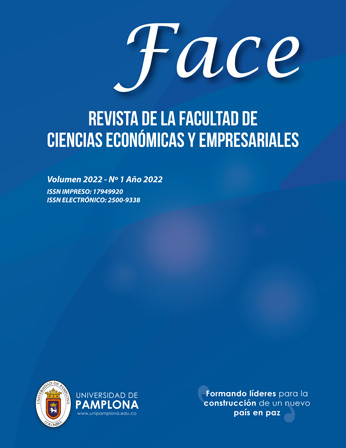Management styles at a Colombian university: the experience in a peripheral region
DOI:
https://doi.org/10.24054/face.v22i1.1491Keywords:
Leadership styles, management styles, former rectors, universitiesAbstract
The general purpose of this study was to learn about the management and leadership styles of former rectors who excelled in a public university located in a peripheral region of Colombia. For this purpose, the proposal of Sánchez (2019) was taken into account, who pointed out that a leader may have an inclination either towards a task-oriented or a people-oriented management and leadership style. The study was qualitative in nature and approached with the analytical-synthetic method. On the other hand, the research was descriptive. Finally, with regard to the results, the former rectors made important contributions to the development of the university according to the interviewees and the documents reviewed.
Downloads
References
Akanji, B., Mordi, T., Ajonbadi, H., & Mojeed-Sanni, B. (2018). Impact of leadership styles on employee engagement and conflict management practices in Nigerian universities. Issues in Educational Research, 28(4), 830-848.
Anderson, H. J., Baur, J. E., Griffith, J. A., & Buckley, M. R. (2017). What works for you may not work for (Gen)Me: Limitations of present leadership theories for the new generation. The Leadership Quarterly, 28(1), 245-260. DOI: https://doi.org/10.1016/j.leaqua.2016.08.001
Baicué, J. E. (2009). Educación superior en un espacio de frontera. Historia y desarrollo académico de la Universidad Surcolombiana 1970-2010. Tesis de Maestría-Universidad Nacional de Colombia. Recuperado de http://bdigital.unal.edu.co/6242/
Barnard, C. (1959). Las funciones de los elementos dirigentes. Madrid: Instituto de Estudios Políticos.
Bass, B. M. (1997). Does the transactional–transformational leadership paradigm transcend organizational and national boundaries? American Psychologist, 52(2), 130-139. DOI: http://dx.doi.org/10.1037/0003-066X.52.2.130
Bernal de Rojas, A. E. (2010). La Universidad Colombiana. Desarrollo Histórico. Paideia Surcolombiana, 1(15), 39-56. DOI: https://doi.org/10.25054/01240307.1089
Bligh, M. C., Kohles, J. C., & Pillai, R. (2011). Romancing leadership: Past, present, and future. The Leadership Quarterly, 22(6), 1058-1077. DOI: https://doi.org/10.1016/j.leaqua.2011.09.003
Blumer, H. (1982). El interaccionismo simbólico: perspectiva y método (trad. Barriga Silverio et al.). España: Hora S.A.
Burns, J. (1978). Leadership. New York: Harper & Row.
Geertz, C. (1994). El sentido común como sistema cultural. En Conocimiento Local. Ensayo sobre la interpretación de la cultura (pp. 93-117). España: Ediciones Paidós.
Goffman, E. (2001). Internados, ensayos sobre la situación social de los enfermos mentales. Argentina: Amorrortu Editores.
Goodall, A. H. (2009). Highly cited leaders and the performance of research universities. Research Policy, 38(7), 1079-1092. DOI: https://doi.org/10.1016/j.respol.2009.04.002
Hernández, R., Fernández, C., & Baptista, M. P. (2010). Metodología de la Investigación (5ª ed.). México DF: McGraw Hill Educación.
Hernandez, M., Eberly, M. B., Avolio, B. J., & Johnson, M. D. (2011). The loci and mechanisms of leadership: Exploring a more comprehensive view of leadership theory. The Leadership Quarterly, 22(6), 1165-1185. DOI: https://doi.org/10.1016/j.leaqua.2011.09.009
Ibarra, M. C. (2014). Fundación de la Universidad Pública del Huila: Años del ITUSCO. Paideia Surcolombiana, 1(18), 9-20. DOI: https://doi.org/10.25054/01240307.1148
Markham, S. E. (2012). The evolution of organizations and leadership from the ancient world to modernity: A multilevel approach to organizational science and leadership (OSL). Leadership Quarterly, 23(6), 1134-1151. DOI: https://doi.org/10.1016/j.leaqua.2012.10.011
Mintzberg, H. (2010). Managing (Traducción Ana del Corral Londoño. Edición 21). Bogotá: Grupo Editorial Norma.
O'Connor, P., & Carvalho, T. (2015). Different or similar: Constructions of leadership by senior managers in Irish and Portuguese universities. Studies in Higher Education, 40(9), 1679-1693. DOI: https://doi.org/10.1080/03075079.2014.914909
Páramo, D. (2009). Le commerce traditionnel colombien: un espace de renforcement culturel pour les consommateurs. Thèse de doctorat. Universite de Geneve. No. SES. 705. DOI: https://10.13097/archive-ouvert/unige:10700
Páramo, D. (2020). Investigación cualitativa: una aproximación básica. En Páramo, D., Campo, Sh., & Maestre, L. (Compiladores). Métodos de investigación cualitativa. Fundamentos y aplicaciones. Editorial Unimagdalena. Santa Marta. Septiembre. pp. 17-48
Piccolo, R. F., & Colquitt, J. A. (2006). Transformational leadership and job behaviors: The mediating role of core job characteristics. Academy of Management Journal, 49(2), 327-340. DOI: https://doi.org/10.5465/amj.2006.20786079
Ramírez, E., & Páramo, D. (2009). Representaciones mentales de los tenderos de barrio. Neiva (Huila, Colombia): Editorial Surcolombiana.
Robie, C., Johnson, K. M., Nilsen, D., & Hazucha, J. F. (2001). The right stuff: Understanding cultural differences in leadership performance. The Journal of Management Development, 20(7), 639-650. DOI: https://doi.org/10.1108/EUM0000000005637
Sánchez, I. D. (2009). Los estilos de dirección y liderazgo en las organizaciones. Propuesta de un modelo para su caracterización y análisis. Cali: Editorial Univalle.
Soto, D. (2005). Aproximación histórica a la universidad colombiana. Revista Historia de la Educación Latinoamericana, (7), 101-138.
Vaughn, M. A. (1995). Organization symbols: An analysis of their types and functions in a reborn organization. Management Communication Quarterly, 9(2), 219-250. DOI: https://doi.org/10.1177/0893318995009002004
Velásquez, V. F. (2002). Escuelas e interpretaciones del pensamiento administrativo. Estudios Gerenciales, 83, 31-55.
Downloads
Published
How to Cite
Issue
Section
License
Copyright (c) 2022 FACE: Revista de la Facultad de Ciencias Económicas y Empresariales

This work is licensed under a Creative Commons Attribution-NonCommercial-ShareAlike 4.0 International License.





